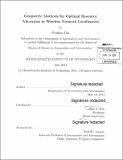Geometric methods for optimal resource allocation in wireless network localization
Author(s)
Dai, Wenhan
DownloadFull printable version (5.317Mb)
Other Contributors
Massachusetts Institute of Technology. Department of Aeronautics and Astronautics.
Advisor
Moe Z. Win.
Terms of use
Metadata
Show full item recordAbstract
Wireless network localization (WNL) is an emerging paradigm for providing high-accuracy positional information in GPS-challenged environments. The localization performance of a node in WNL is determined by the allocation of transmit resources among its neighboring nodes. To achieve the best localization performance, we develop a computational geometry framework for optimal resource allocation in WNL. We first determine an affine map that transforms each resource allocation strategy into a point in 3-D Euclidian space. By exploiting geometric properties of these image points, we prove the sparsity property of the optimal resource allocation vector, i.e., the optimal localization performance can be achieved by allocating resources to only a small subset of neighboring nodes. Moreover, these geometric properties enable the reduction of the search space for optimal solutions, based on which we design efficient resource allocation strategies. Numerical results show that the proposed strategies can achieve significant improvements in both localization performance and computation efficiency. Our approach provides a new methodology for resource allocation in network localization, yielding exact optimal solutions rather than e-approximate solutions.
Description
Thesis: S.M., Massachusetts Institute of Technology, Department of Aeronautics and Astronautics, 2014. Cataloged from PDF version of thesis. Includes bibliographical references (pages 81-84).
Date issued
2014Department
Massachusetts Institute of Technology. Department of Aeronautics and AstronauticsPublisher
Massachusetts Institute of Technology
Keywords
Aeronautics and Astronautics.